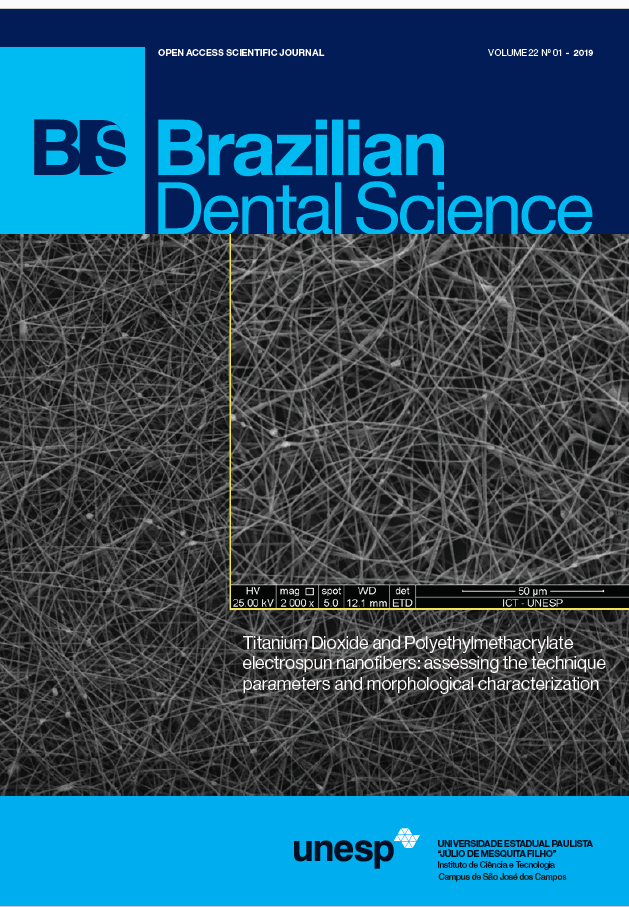Microleakage of high viscosity glass-ionomer and glass-carbomer with and without coating before and after hydrothermal aging
DOI:
https://doi.org/10.14295/bds.2019.v22i1.1631Abstract
Objective: The objective of this study was to evaluate the microleakage patterns of GIC and GGC with and without their protective surface coatings on enamel and dentin margins before and after aging. Material and Methods: Two rectangular cavities (height: 2 mm; width: 3 mm; depth: 1.5 mm) were prepared on each tooth at the cemento-enamel junction were prepared on human permanent molars (N=56) and the teeth were randomly assigned to be restored with one of the following: a) high viscosity glass-ionomer cement (GIC) (EQUIA Fil, C Corp., Tokyo, Japan) (n=28), b) glass-carbomer cement (GCC) (Glass Carbomer Products, Leiden, The Netherlands) (n=28). Half of the teeth were further divided into two groups where one group received protective surface coating (SC) (G-Coat Plus, GC Corp) (n=14) and the other group did not (n=14). Half of the teeth were stored for 24 hours (n=7), and the other half was thermocycled (5000 cycles, 5-55°C) (n=7). For microleakage analysis, the teeth were immersed in 5% methylene blue dye for 24 hours, sectioned into two equal halves. Microleakage patterns were evaluated using stereomicroscope and scored on a scale of 0-3 (0: No dye penetration, 1: Dye penetration less than half of the axial wall, 2: Dye penetration more than half the axial wall, 3: Dye penetration spreading along the axial wall). Data were analyzed using Kruskal-Wallis tests at the significance level of 0.05. Results: Compared to 24 h storage, after thermocycling, surface coating on GIC decreased microleakage significantly compared to GCC (p=0.046) but not for GCC. In the thermocycled groups, coated GIC showed significantly less leakage at the enamel margin but no significant difference was found with both GIC and GCC in the dentin margins. Conclusion: The application of surface coating significantly reduced the microleakage scores of GIC but not GCC, within the enamel margins only.
Keywords
Glass-carbomer; Glass-ionomer; Microleakage.
Downloads
Downloads
Additional Files
Published
How to Cite
Issue
Section
License
Brazilian Dental Science uses the Creative Commons (CC-BY 4.0) license, thus preserving the integrity of articles in an open access environment. The journal allows the author to retain publishing rights without restrictions.
=================
COPYRIGHT TRANSFER AND RESPONSIBILITY STATEMENT
(PDF)
For all articles published in the BDS journal, copyright is retained by the authors. Articles are licensed under an open-access Creative Commons CC BY 4.0 license, meaning that anyone may download and read the paper for free. In addition, the article may be reused and quoted, provided that the original published version is cited. These conditions allow for maximum use and exposure of the work while ensuring that the authors receive proper credit. All metadata associated with published articles is released under the Creative Commons CC0 Universal Public Domain Dedication.
Before the submission, authors must obtain permission to reproduce any published material (figures, schemes, tables, or any extract of a text) that does not fall into the public domain or for which they do not hold the copyright. Permission should be requested by the authors from the copyright holder (usually the Publisher, please refer to the imprint of the individual publications to identify the copyright holder).
The authors hereby attest that the study is original and does not present manipulated data, fraud, or plagiarism. All names listed made a significant scientific contribution to the study, are aware of the presented data, and agree with the final version of the manuscript. They assume complete responsibility for the ethical aspects of the study.
This text must be printed and signed by all authors. The scanned version should be submitted as supplemental file during the submission process.
























